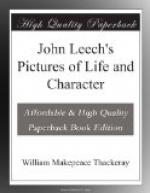Our story-books had no pictures in them for the most part. Frank (dear old Frank!) had none; nor the “Parent’s Assistant;” nor the “Evenings at Home;” nor our copy of the “Ami des Enfans:” there were a few just at the end of the Spelling-Book; besides the allegory at the beginning, of Education leading up Youth to the temple of Industry, where Dr. Dilworth and Professor Walkinghame stood with crowns of laurel. There were, we say, just a few pictures at the end of the Spelling-Book, little oval gray woodcuts of Bewick’s, mostly of the Wolf and the Lamb, the Dog and the Shadow, and Brown, Jones, and Robinson with long ringlets and little tights; but for pictures, so to speak, what had we? The rough old wood-blocks in the old harlequin-backed fairy-books had served hundreds of years; before our Plancus, in the time of Priscus Plancus—in Queen Anne’s time, who knows? We were flogged at school; we were fifty boys in our boarding-house, and had to wash in a leaden trough, under a cistern, with lumps of fat yellow soap floating about in the ice and water. Are our sons ever flogged? Have they not dressing-rooms, hair-oil, hip-baths, and Baden towels? And what picture-books the young villains have! What have these children done that they should be so much happier than we were?
We had the “Arabian Nights” and Walter Scott, to be sure. Smirke’s illustrations to the former are very fine. We did not know how good they were then; but we doubt whether we did not prefer the little old “Miniature Library Nights” with frontispieces by Uwins; for these books the pictures don’t count. Every boy of imagination does his own pictures to Scott and the “Arabian Nights” best.
Of funny pictures there were none especially intended for us children. There was Rowlandson’s “Doctor Syntax”: Doctor Syntax in a fuzz-wig, on a horse with legs like sausages, riding races, making love, frolicking with rosy exuberant damsels. Those pictures were very funny, and that aquatinting and the gay-colored plates very pleasant to witness; but if we could not read the poem in those days, could we digest it in this? Nevertheless, apart from the text which we could not master, we remember Doctor Syntax pleasantly, like those cheerful painted hieroglyphics in the Nineveh Court at Sydenham. What matter for the arrow-head, illegible stuff? give us the placid grinning kings, twanging their jolly bows over their rident horses, wounding those good-humored enemies, who tumble gayly off the towers, or drown, smiling, in the dimpling waters, amidst the anerithmon gelasma of the fish.




